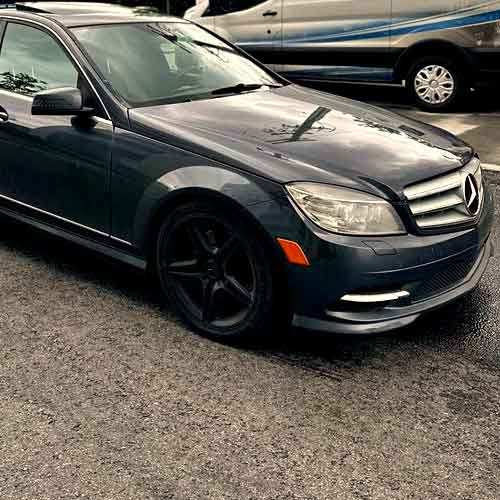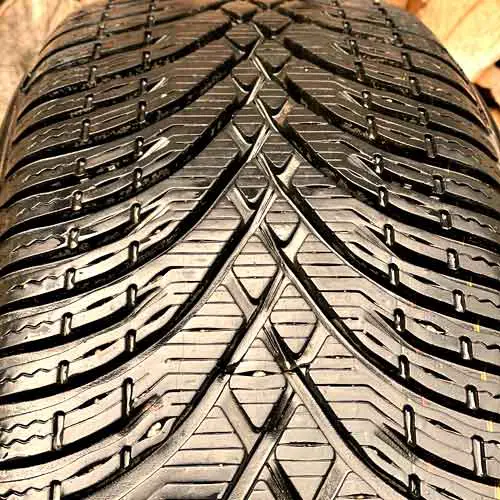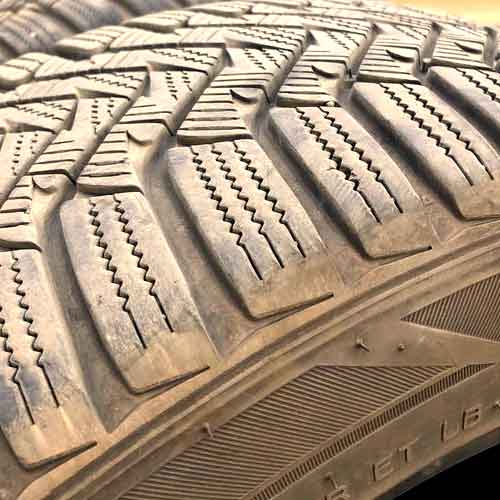The Kleber Krisalp HP3 and the BF Goodrich G Force Winter 2, are both known for their distinctive performance, so its best to consider the following performance sections, starting with their sizes.

Table of Contents
Key Takeaway
BFGoodrich G Force Winter 2 excels in:
- Icy terrains: Especially notable braking distance and overall handling.
- Wet traction: Enhanced biting abilities with its dual siping system and effective water displacement during various maneuvers.
- Comfort: Produces less noise due to its tread design, offering a quieter ride.
On the other side, the Kleber Krisalp HP3 (review) stands out for:
- Snow performance: Superior traction, especially on soft, fluffy snowscapes.
- Dry traction: Better handling and directional grip due to continuous running rib and lesser weight.
- Fuel Economy: Lighter framework and streamlined design lead to more fuel-efficient consumption.
- Both tires are comparable in:
Also both tires have similar scores in terms of tread longevity, where despite their differences, both offer similar tread life.
Tire Sizes
On the other side, the BF Goodrich Winter T/A KSI comes in 57 total sizes, with following specs.
- Wheels or rims available: 14 to 20 inches.
- Speed ratings: H and T.
- Load ratings: SL and XL
- Tread depth: 12/32″ on all.
- Weight: 16 to 41 lbs.
On the other side, the Kleber Krisalp HP3 comes in 99 total sizes, in following specs.
- Rims available: 14 to 20 inches.
- Speed ratings: T and H (similar to BFG).
- Load ratings: SL and XL.
- Tread depth: 10/32″.
- Weight: 16 to 32 lbs, (on average, the tire is lighter in weight).
Side Note: Both tires don’t come with any tread wear warranty, and both of them have M+S ratings, along with the standard 3 peak mountain snowflake ratings (you normally seen on winter tires).
Snow Performance
When it comes to soft, salt-like snow, both tire models exhibited stellar performance, each tackling the distinct challenges that different types of snow impose. Yet, the Kleber Krisalp HP3 edged out as the victor in terms of traction, notably on soft, fluffy snowscapes.

The secret? It lies in the tread design of this tire.
Sporting a more assertive directional tread pattern, coupled with lugs that boast an expansive structure, this tire carries a definitive advantage.
It’s designed to optimize snow-to-snow interaction.
The soft snow particles are effortlessly captured by the tire’s interlocking grooves and snow vices.
Once ensnared, these particles boost the tire’s grip, facilitating superior traction as snow naturally adheres better to itself than to rubber.
In comparison, the design of the BFGoodrich G Force Winter 2 is more compact, even though the tire offers similar cocntinous running V shaped lugs, (due to their reinforced foundations), as can be seen in their treads (images).
Moreover, the BFG’s absence of thick in-groove notches, like seen shoulders of Kleber, means the tire doesn’t amass as much snow as its competitor, leading to a slight decline in performance under snowy conditions.
Ice Performance
Now although the BF Goodrich G Force Winter 2 lacks on snow, it interestingly takes the lead, when it comes to icy terrains, where the tire unveils impressive abilities, especially notable in its braking distance, which is also contributes to it’s overall handling.
(As during turns, you need to slow down first).

And in a side-by-side evaluation, on average, the BFG grinds to a halt an impressive 10 feet shorter.
The reason behind this? Well there are a couple.
Actually, the tire is made with a compound composition which sticks well to ice, for the most part.
Moreover, it’s complex biters of various dimensions, presenting angled incisions, curved V-shaped notches, facing the shoulders (as can be seen in the image), and interlocking siping, further add to it’s performance.
As these features contribute to the tire’s enhanced capacity to grip/bite into ice.
In contrast, the Kleber Krisalp HP3 grapples with larger tread voids and fewer notches.
Meaning it has less no. of biters per square inch of it’s tread.
Moreover, the tire only offers linear siping, particularly in the central region, and that combined with wider voids, it struggles to obtain a secure grip on compact ice.
Wet Traction
The combination of tread design and rubber compound largely prescribes a tire’s aptitude for wet traction.
While both tires are well-equipped with generous siping and soft, thermally adaptive rubbers, the BF Goodrich G Force Winter 2 manages to edge ahead.
And to understand the why behind that, its crucial to understand siping first.
Sipes essentially function by expelling air and absorbing water particles. The BFG, with its dual siping system that comprises aggressive interlocking and rectilinear designs, yields enhanced biting abilities on icy surfaces.
Additionally, its multi-angled sipes effectively displace water in all directions during cornering, braking, or acceleration.
In contrast, the Kleber Krisalp HP3 adopts a different siping strategy, featuring solely a lateral orientation, thus failing to achieve comparable results.
However, it does earn plaudits for its commendable performance in hydroplaning resistance.
In both curved and straight aquaplaning tests, the tire demonstrated slightly higher speeds. This improved performance is attributable to its interconnected network of grooves that disperse water in all directions more proficiently than its counterpart’s continuous central rib.
So overall, the BFG tire gets to offer superior overall wet traction.
Dry Traction
Dry traction evaluations primarily focus on two critical aspects: directional grip and lateral traction.
Here, the Kleber Krisalp HP3 owing to its continuous running rib which assures unwavering surface contact. This benefit translates into abbreviated braking distances and expedited acceleration times.
Though most of its advantage comes form its smaller weight. Not only it leads to augmented lug movement during cornering, causing a decrease in steering feedback, but also add to overall momentum, which makes its braking difficult.
On the other hand, although the BF Goodrich G Force Winter 2 is pretty great with its compact strcuture, its greater tread depth on average and weight, slows down the tire, as seen by it’s handling time tests.
Therefore, overall, Kleber tire is seen with superior handling and directional grip.
Comfort Levels
Comfort in a tire results from a delicate balance of factors such as ambient road noise and the absorption of vibrations, both of which are influenced by the tread pattern and sidewall design of the tire.
On the noise front, the BF Goodrich G Force Winter 2 nudges ahead slightly, courtesy of its less-voided tread design, thereby permitting less air to penetrate and swirl around (thus generating noise).
Coupled with its leaner weight, it also facilitates faster response times, ensuring a smoother overall ride compared to its rival.
The Kleber Krisalp HP3, however, claims an advantage with its softer rubber compound, which is more proficient at buffering road bumps, in comparison here.
Still, the BFG proves to be the quieter choice, relatively.
Fuel Economy
Fuel efficiency in a tire is largely governed by its adhesion to the surface and its total weight.
The G Force Winter 2 stumbles in both these domains, with its substantial weight, even though it doesn’t have as broader tread voids as it competitors, (because greater voids, resulting in heightened friction as the tire traverses the road).
Now although the BF Goodrich’s tire’s performance visibly improves under extreme winter temperatures, its drawbacks in this context are indisputable.
On the contrary, the Kleber coming with a lighter framework better aligned ribs (with less tread features), ensures a more aerodynamic and streamlined maneuver, especially for straight-line travels such as on highways.
This design results in more fuel-efficient consumption by reducing energy wastage.
So overall, in terms of fuel economy, the Krisalp HP3 certainly comes out on top.
Tread Life
Rolling resistance also impacts tread longevity.
In this domain, although the Krisalp HP3 has the edge of it’s leaner structure, which exerts less overall force on its tread blocks, resulting in lesser friction and slower wear, it still has similar tread life compared to BFG.
So why is that?
Well, this is because, the BF Goodrich G Force Winter 2 comes with a greater tread depth (2/32″ greater on average, looking at all sizes).
And this means rubber needs to wear down 2/32″ more to reach towards tire replacement levels.
So even though the tire bears a larger weight and a smaller total rubber area, which creates more weight pressure and grates against the road with more friction, it still offers just as great tread life overall.
So, when it comes to tread longevity, it’s a tie between both tires.
Summing Up
So overall both tires are great and have their pros and cons.
In snow conditions, the Kleber Krisalp HP3’s tread design offers superior traction, whereas the BFG excels on icy terrains due to its unique compound and tread design.
In wet conditions, BF Goodrich edges out with its advanced siping, but its competitor shines in dry traction with its continuous rib and lighter weight.
Comfort-wise, BFGh is quieter, while Kleber offers better bump absorption.
And yes, for fuel efficiency, Kleber leads with its streamlined design, but both tires tie in tread longevity despite their individual advantages.